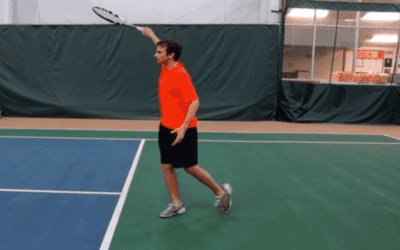Serve and Volley Tips
How would you like to serve and volley effortlessly like the pros? Are you making any of my top four most common serve and volley mistakes? In this tennis blog, I will share with you tennis movement and split step tips to improve your serve and volley game. Moreover, I will give you a drill you can do by yourself to correct them.
Common Serve and Volley Mistakes

Before I discuss how to practice your serve and volley, I want to go over what not to practice. There are four primary mistakes I see people make while serving and volleying. The first two focus on the server’s approach to the net. First, approach the net with short strides. Instead of taking several small steps, take one to three big strides. You will see more success with bigger strides. Second, stand up tall after the serve. If you stay low after serving, you can take fewer, but larger steps to achieve a better approach.
The third mistake is splitting at the service line. There is a common misconception that when you serve and volley, the split step must be at the service line. In reality, it is okay for your split step to be in no man’s land, as long as you move forward to hit your volley in front of the service line. The fourth is splitting and ceasing all forward momentum. Try not to stop all of your forward movement with your split step. Think of your split step as a “split and move” instead of split and stop. You want your approach to be a continuous flow.
How To Split Step and Move

When it comes to serving and volleying, split step footwork is a hot topic. Think about your own split step. Is your split step narrow or wide? Do your feet touch the ground at the same time or are they staggered? A wide split step provides a good base and balance for your volley. Touching both feet to the ground evenly at the same time during your split step stops your forward momentum completely. In order to move forward after a volley, you have to restart that forward momentum, and that takes more time. Instead of a split step, think split and move. Both feet should not hit the ground at the same time to keep the movement continuous.
If I had to choose between a player that splits and stops and one that does not split, I will take the person that moves. The reason being, the moving player has momentum going towards the ball. Sure, that creates a reaction problem, but I would take my chances with the player moving continuously. The player that splits and stops will have to completely start their forward momentum again.
Serve and Volley Tennis Movement

During a serve and volley tennis movement, there are three primary times to focus on a continuous motion. The split step, volley follow through, and volley recovery should all focus on continuous motion. Let’s break down each of these motions during a serve and volley. First, as we discussed before, try not to completely stop during your split step. Stagger your feet, so they do not touch the ground at the same time. Continually flow through the split step motion.
Second, when you follow through after contact for a volley, hold the finishing position. Do not immediately reset the racquet, but hold the finish position as you move to your recovery position. Last, make sure you recover after you hit your volley. Try not to stop your feet immediately after hitting a volley because you will not be in a good position to play the next ball. Recover slightly down the line from where you hit your volley.
The Problem with Serve and Volley Practice

The challenge with practicing the serve and volley is, there is really only one way to practice: play matches. If you are a competitor like me, it is difficult to practice serving and volleying in a match if it is not a skill that you are comfortable with. The only way to practice at home is to have a partner willing to feed you balls.
It is much harder for those of you that do not have someone to feed you balls. It is also difficult to practice when you compete because of little repetition. Repetition can also be particularly difficult if the return does not come back. Over the course of a set, you may only hit five volleys when you serve and volley. This simply is not enough repetition to make true improvements.
The Solution: How to Practice Serve and Volley

You may be thinking, with no good way to practice a serve and volley, how am I supposed to improve? I recommend using the shadow stroke method to improve your tennis movement. Learn the tennis movements and concepts first. Most tennis players are not going to spend time on their tennis movement. If you are committed to learning to serve and volley, this is a great place to start. Here are three steps to practice your serve and volley tennis movement. No partner or ball needed!
First, perform a shadow serve stroke; mimic a service motion without hitting a ball. Second, recover forward and split and move. Stay low, take one to three steps forward, and stagger your feet to split and move. Third, move forward to hit a shadow volley, step forward toward the invisible ball, and mimic hitting a volley. Fourth, recover after the shadow volley. Hold your volley finish position while continuously moving your feet to a proper volley recovery position.
Conclusion
In conclusion, know that a good serve and volley is all about developing rhythm, timing, and flow. Get a good rhythm down and move the right way. Avoid the little choppy steps, do not stop on your split step, and keep moving through it. Hit a volley, and keep moving after the volley to your recovery spot. Shadow stroking the serve and volley can help you understand the rhythm of moving forward on a serve and volley. Practice it on your own time without a ball. This is not easy if you have not practiced tennis movement skills before, but these tips can get you to the next level for your serve and volley game.
By Jeff Salzenstein, Founder Tennis Evolution
Jeff is a former top 100 ATP player and USTA high performance coach committed to helping players and coaches all over the world improve.
P.S. – Want to take your serve to the next level? Avoid power leaks on your serve with this little known “elbow the enemy” move. Click here to get instant access.


0 Comments